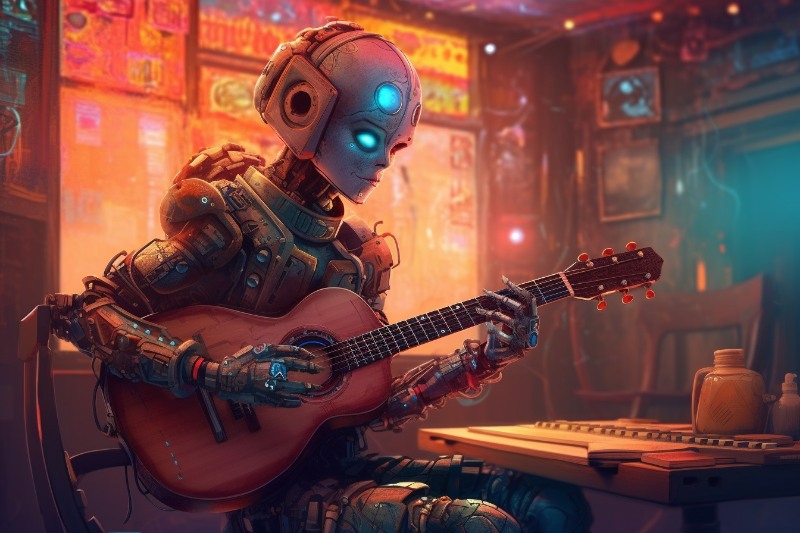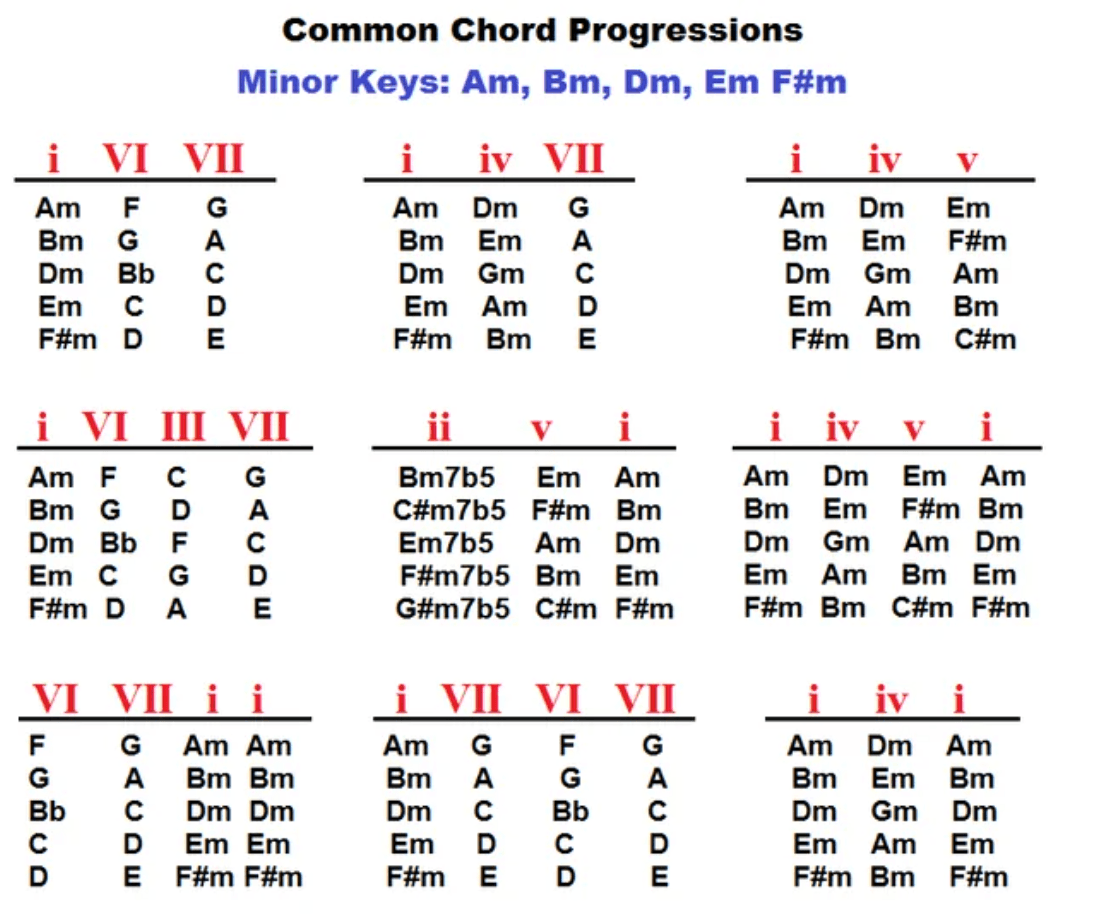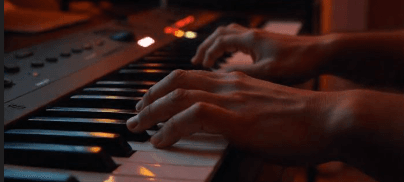Ever thought about the magic behind an AI music composer? Within the realm of artificial intelligence (AI), there lies a captivating transformation in the way music is composed and produced.

The marriage of music and AI offers a fascinating frontier, unlocking realms previously the reserve of human maestros.
This article delves into how this captivating technology is reshaping the music world.
Understanding the Power: Generative AI and Large Language Models
The fusion of Generative AI and Large Language Models with music isn't just a technological advancement; it's a cultural shift.
As these models continue to evolve, so will their contributions to the world of audio production, pushing boundaries and setting new benchmarks in creativity.
The Core Concepts: Generative AI and LLMs Unveiled
Generative AI operates based on the principle of generating new content from existing data.
It analyzes vast data sets to identify patterns and create original outputs. On the other hand, Large Language Models (LLMs) like GPT-3 and ChatGPT were designed to understand and generate human-like text based on the data they were trained on.
These models have become pivotal in showcasing the prowess of artificial intelligence in generating content that feels innately human.
From Text to Tune: Diversifying Applications
It's fascinating how these models, once limited to text generation and language translation, have transitioned into the realm of audio production.
By feeding these models a diverse range of musical compositions, they've learned to understand the intricacies of various genres, rhythms, and styles.
This shift exemplifies AI's versatility, transcending boundaries and reshaping industries.
Mirroring Humanity: AI's Art of Duplication
One of the most astounding capabilities of these tools is their proficiency in mirroring human expressions.
Whether it's a piece of text or a music composition, the output resonates with emotions, intricacies, and nuances similar to human-made creations.
The fine line between an AI music composer's creation and a maestro's masterpiece is blurring, making it difficult to discern AI-generated content from human-produced ones.
Harmonizing AI with Music: A Symphony of Innovation
Merging music and AI has cultivated an innovative domain where the creative potential feels boundless.
Musicians, producers, and composers can now harness AI to assist, inspire, and even challenge their traditional processes.
Whether it's generating a catchy melody, devising intricate harmonies, or even getting a base for a composition, AI music tools offer solutions that seemed far-fetched a decade ago.
The Musical Masterpiece Generator: AI in Composition
As the lines between human-made and AI-generated music intersect, the realm of composition undergoes an exciting transformation.
Audio production enriched with AI music tools not only pays homage to legendary composers but also paves the way for avant-garde creations.
The symphony of the future promises a harmonious blend of human creativity and artificial prowess.
Bridging the Past with the Present: AI's Musical Training
Before an AI music composer can generate an aria or symphony, it undergoes rigorous training.
Developers feed these models with a plethora of musical compositions, ranging from baroque and classical to jazz and pop.
As the AI assimilates these styles, it gains a deep understanding of rhythm, harmony, and melody that characterizes each composer and genre.
This data-driven training forms the bedrock for the AI's subsequent musical creations.
The Charm of Classics: Reviving Mozart and Beethoven
Ever yearned for a composition evoking the spirit of classical legends?
With audio AI tools, that dream isn't far from reality. Once trained, the AI music tool can generate pieces infused with the nuances and styles of iconic musicians like Mozart, Beethoven, or Chopin.
It's like having a touch of the classical era available, ready to be summoned on demand.
Beyond Imitation: Crafting Original AI Masterpieces
While it's enchanting to hear AI-produced tracks mirroring legendary composers, the true prowess of artificial intelligence lies in its capacity for originality.
By integrating various styles, rhythms, and genres, these models can generate entirely unique compositions.
These aren't just replicas but are fresh, original masterpieces with their own distinct flair, showcasing AI's potential to be not just a mimic but a true creator in the realm of music.
Empowering the Modern Composer: A Collaborative Future
Modern musicians stand at the cusp of a revolution.
With AI music tools, they can draw inspiration, test novel harmonies, or even challenge conventional composition methods.
It's not about replacing the human composer but augmenting their capabilities.
By using AI as a co-composer, musicians can explore uncharted musical territories, resulting in a rich tapestry of innovative soundscapes.
The Elements of Composition
1. Style: The Foundation of Composition
Choosing a style is the first and pivotal step in composing.
Whether it's classical, rock, jazz, or folk, your chosen style will influence the mood, tempo, and instrumentation of your piece. Understanding what makes a genre distinct is vital.
Delve into your favorite pieces to uncover the unique elements that place them in their respective genres. For instance, a rock song might be identified by its steady 4/4 beat and its emotive lyrics.
Once you've identified these elements, sketch out the initial direction for your piece, deciding on aspects like the inclusion of lyrics. For illustrative purposes, let’s envision a simple piano composition in a classical style with a medium tempo and cheerful mood.
2. Form: Structuring Your Musical Piece
Music thrives on structure. A composition's form is delineated by its sections, which can either repeat or contrast with each other.
Familiarize yourself with common forms specific to your chosen style—be it the 32-measure AABA pattern in jazz or the 12-bar blues format. While adhering to established forms can be helpful, don't hesitate to craft your own unique structure.
A straightforward approach is to create two contrasting eight-measure sections, which can serve as the foundation for a 32-bar AABA composition.
3. Create Ideas: The Birth of Musical Concepts
Embrace the power of technology to incubate your musical ideas.
Use devices like tape recorders, computers, or minidiscs to capture snippets of melodies or riffs, either vocalized or played on an instrument.
Give yourself the freedom to experiment during this phase—perfection isn't the goal, exploration is.
4. First Musical Motif: Recognizing the Gem
Sift through your recorded ideas to pinpoint any standout segments.
Can you discern the makings of a classical melody or the foundations of a chord progression for a rock piece?
This discerned fragment, no matter how short or simple, is your musical motif—a kernel of musical thought that will permeate your entire piece.
Try to transcribe this motif, playing or singing it to grasp its essence.
5. Edits: Refining the Raw Material
Once your motif is in place, it’s time to mold it. Experiment by expanding, contracting, inverting, or repeating it.
This iterative process transforms your motif into a fuller musical phrase, which is essentially a more complete representation of your musical thought.
Using our ongoing example, the motif could be adjusted and reiterated in a different key, with subtle rhythmic variations, to span an eight-measure phrase.
6. Contrasting Section: Introducing Variety
Every memorable composition has moments of surprise. Introducing a contrasting section ensures your piece remains engaging, offering listeners something fresh to anticipate.
This section serves the same purpose as a bridge in pop songs or a B section in jazz.
When crafting this section, veer away from your original motif. Introduce new rhythms, melodic progressions, and perhaps even a mood shift.
7. Combine: Assembling the Musical Puzzle
Having sculpted distinct sections, you now face the task of arranging them coherently.
Reflect on your initial form—does your current composition align with your original vision? If not, feel empowered to modify.
Consider whether your piece feels complete or if it necessitates an additional section.
Ponder on its conclusion and any supplementary elements that would render it performance-ready. Harmonizing parts for other instruments or vocalists can further enrich your composition.
Remember:
A foundational understanding of music theory is very beneficial for the creation of musical compositions, however it's not imperative. Experimentation is key!
Harness your intuition and creativity to craft chords and harmonies.
For instance, in our hypothetical composition, the final melody could be tweaked to offer closure, complemented by a harmonious left-hand piano part.
Introducing Empress AI Music Tools for Composition
Empower your musical endeavors with Empress AI Music Tools.
This state-of-the-art suite of tools harnesses the prowess of artificial intelligence to assist composers, musicians, and hobbyists in creating enthralling musical pieces.
Let's delve into these remarkable tools and discover how they can transform your composition process.
1. Melody Mind: Your AI-Assisted Melody Composer
Melody Mind is not just a tool—it's your musical confidante. By seamlessly blending AI capabilities with human creativity, this tool crafts captivating melodies. To start, simply:
a. Instrument: Choose from an expansive array of instruments, from classical violins to electric guitars.
b. Chords: Define the chord progression, whether you're aiming for a soothing I-IV-V or a more complex jazz progression.
c. Genre: Select from numerous musical genres—be it upbeat pop, soulful blues, or energetic EDM.
d. BPM: Set your desired beats per minute, dictating the pace of your piece.
For example, if you input an electric guitar, an A-G-D chord progression, rock genre, and a BPM of 120, Melody Mind could generate a powerful rock anthem riff reminiscent of legendary rock bands.
2. Lyric Lab: Craft Captivating Verses with AI
Transport your audience to another realm with Lyric Lab. Craft verses that resonate, all with a touch of AI:
a. Genre: Whether you're aiming for a soulful ballad or a Futuristic Sci-Fi song, pick your preferred genre.
b. Tone/Style: Decide on the overall feel of the lyrics. Choose tones like "hopeful," "melancholic," or even "ominous" to give your song its unique character.
For instance, inputting "Futuristic Sci-Fi" as the genre and "ominous" as the tone could generate lyrics like: "In a world where stars have died, machines arise, humanity's last sigh."
3. Chord Candy: Harmonize with Intelligence
Crafting the perfect chord progression becomes a breeze with Chord Candy. Just input the following:
a.Instrument: Specify which instrument you will be working with, i.e. a piano, ukulele, or any other instrument.
b. Key: Determine the musical key, from haunting minor scales to uplifting major ones.
c. Genre and BPM: Like with Melody Mind, select your genre and tempo.
As an example, selecting a piano, key of C major, jazz genre, and BPM of 90 might yield a smooth, jazzy progression that transports listeners to a dimly lit, cozy jazz bar.
4. Song Idea Generator: Evoke Your Vision with AI
Perhaps the most abstract yet invaluable tool in the suite, the Song Idea Generator helps you conceptualize entire pieces based on emotional direction and themes. To utilize it:
Theme/Emotion: Input feelings or themes like "Depression," "Euphoria," "Serendipity," or "Adventure."
For example, choosing "Euphoria" might suggest a fast-paced, major-keyed song with energetic drums and uplifting lyrics, while "Depression" could inspire a slow, melancholic ballad with poignant lyrics and a subdued melody.
Empress AI Music Tools brings a fresh, innovative edge to the world of music composition.
By combining human creativity with AI's computational power, it promises to revolutionize how we approach the art of song creation.

The Maestro Behind the Curtain: Brett Bauman's Vision
The fusion of art and technology is a delicate ballet. Leading this dance with grace, precision, and an indomitable spirit is Brett Bauman.
His work, ever-resonant in the AI-music arena, has been nothing short of transformative.
Brett's belief in AI's capability to amplify human potential in music creation is deep-rooted, stemming from a love for both fields.
The Prodigy's Origin: A Journey of Passion
Before Brett became synonymous with AI-powered music innovation, he was an avid music enthusiast.
From strumming guitars in dimly lit rooms to mastering complex symphonies, his love for music was palpable.
But as the tides of technology surged, Brett, intrigued by AI's burgeoning potential, began to envision a world where technology enhanced, rather than replaced, human creativity.
More Than Just A Composer: AI as an Enabler
Brett's approach to AI in music isn't about machines replacing human talent. Instead, he views AI as an enabler, a tool that artists can use to refine, expand, and experiment.
He often cites that AI, with its computational might, can evaluate thousands of musical possibilities in seconds, providing artists with options they might never have considered.
Yet, in Brett's orchestra, the human element remains the conductor, with AI offering a plethora of instruments to choose from.
Democratizing Music: Brett's Ultimate Vision
One of the most profound elements of Brett's vision is the democratization of music creation.
Recognizing that not everyone has access to expensive musical equipment or elite training, Brett's AI initiatives aim to democratize music.
With simple user interfaces, his tools are designed for everyone—from a budding artist in their bedroom to seasoned professionals in studios.
By leveling the playing field, Brett hopes to ignite a renaissance in music, where barriers are diminished, and creativity knows no bounds.
A Fusion of Prowess and Parameters: The Masterstroke
Brett's most iconic project elegantly blends AI's raw power with the nuances of human input.
By allowing users to define parameters—like genre, mood, or instrument—he ensures that the music generated is both unique and personal.
This intersection of AI prowess and user-driven parameters stands testament to Brett's genius, sculpting a space where technology and humanity harmoniously coexist.
Brett Bauman, through his innovative endeavors, has redefined the realms of AI and music.
His vision ensures that as we march into a technologically-driven future, the soulful essence of music remains untouched, enriched, and ever-evolving.
Striking the Right Chord: How AI Composes Music
As we embark on a journey into the AI-musical nexus, it's essential to recognize the underlying mechanisms and principles.
The melding of AI with music, though intriguing, is grounded in methodical processes and data-driven insights.
Musical Datasets: The Symphony's Blueprint
The first step in this orchestration involves feeding the AI with a rich musical dataset.
Think of this as the AI's preliminary music lessons—just as a budding musician learns from listening to diverse compositions, AI requires a vast array of musical pieces to understand the patterns, cadences, and structures that define music.
Pattern Recognition: AI's Analytical Ear
Post its extensive 'listening' phase, the AI begins to grasp musical patterns and structures.
Through intricate algorithms and neural networks, it discerns recurring motifs, chord progressions, and even rhythmic structures.
Over time, it can predict which note might naturally follow another or which chord progression evokes a particular emotion.
Interactivity and User Prompts: Customizing the Melody
One of the marvels of AI-driven music is its responsiveness to user preferences.
Rather than just churning out generic tunes, users can provide prompts or preferences.
Desiring a melancholic ballad or an upbeat jazz number? Specify your mood, tempo, and style, and the AI obliges, crafting a melody that aligns with your vision.
The Final Crescendo: AI's Melodic Offering
With the groundwork set and parameters defined, AI spins out a personalized, tuneful composition.
This final product is an amalgamation of vast musical knowledge and user-specific desires—tailored, timely, and tuneful.
The Highs and Lows of AI-Driven Compositions
The benefits of AI-generated music are manifold:
a. Swift idea generation: Artists can now rapidly prototype melodies, facilitating quicker creative processes.
b. Exploration across diverse musical styles: From reggae to baroque, AI can seamlessly traverse genres, offering a smorgasbord of musical experiences.
c. Simulations of legendary composers' styles: Want a composition reminiscent of Chopin or Miles Davis? AI serves as a repository and learning resource, enabling users to tap into iconic styles.
d. The Valleys: Recognizing AI's Limitations
However, AI music is not without its challenges:
a. Emotional Nuances: Music, at its core, is a conduit of emotions. While AI can mimic styles and structures, it may sometimes miss the raw, emotional nuances—a tear, a sigh, or a heart's flutter—that human composers naturally imbue.
b. The Essence of Originality: AI is, after all, an amalgamation of existing knowledge. While it's a potent catalyst for creativity, it's not a replacement. The heart, soul, and spontaneity that human artists introduce are irreplaceable.
While AI is undeniably revolutionizing the musical landscape, striking the right balance between machine-generated precision and human-inspired creativity is the key to truly striking the right chord.
FAQs: AI Music Composer
Q1: What is an AI music composer?
An AI-powered tool that analyzes musical data to create original compositions.
Q2: How does AI generate music?
By learning from vast musical datasets and mimicking styles of various composers.
Q3: Are all AI-generated songs unique?
While AI strives for originality, some patterns may be repetitive or echo existing styles.
Q4: Can AI replace human musicians?
AI offers tools for enhancement, not replacement. The human touch in music remains irreplaceable.
Q5: Ready to experiment with AI in your music journey?
Why not give it a shot and see how it transforms your creations?
Follow the future of music with Empress. Check out our blog to learn how you can effectively use these AI music tools.


